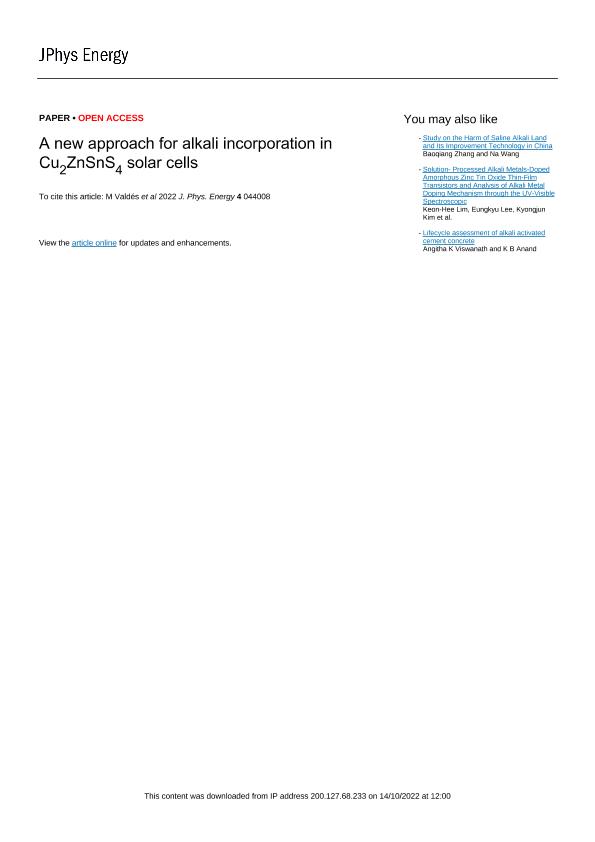Artículo
A new approach for alkali incorporation in Cu2ZnSnS4 solar cells
Valdes, Matias Hernan ; Hernandez, A.; Sánchez, Y.; Fonoll, R.; Placidi, M.; Izquierdo, V.; Cabas Vidani, A.; Valentini, M.; Mittiga, A.; Pistor, P.; Malerba, C.; Saucedo, E.
; Hernandez, A.; Sánchez, Y.; Fonoll, R.; Placidi, M.; Izquierdo, V.; Cabas Vidani, A.; Valentini, M.; Mittiga, A.; Pistor, P.; Malerba, C.; Saucedo, E.
 ; Hernandez, A.; Sánchez, Y.; Fonoll, R.; Placidi, M.; Izquierdo, V.; Cabas Vidani, A.; Valentini, M.; Mittiga, A.; Pistor, P.; Malerba, C.; Saucedo, E.
; Hernandez, A.; Sánchez, Y.; Fonoll, R.; Placidi, M.; Izquierdo, V.; Cabas Vidani, A.; Valentini, M.; Mittiga, A.; Pistor, P.; Malerba, C.; Saucedo, E.
Fecha de publicación:
10/2022
Editorial:
IOP Publishing
Revista:
Journal of Physics: Energy
e-ISSN:
2515-7655
Idioma:
Inglés
Tipo de recurso:
Artículo publicado
Clasificación temática:
Resumen
The addition of alkali elements has become mandatory for boosting solar cell performance in chalcogenide thin films based on kesterites (Cu2ZnSnS4, CZTS). A novel doping process is presented here, that consists in the incorporation of sodium or lithium during the deposition of the CdS buffer layer, followed by a post-deposition annealing (PDA). As the doping route leads to more efficient devices in comparison with the undoped reference sample, the influence of PDA temperature was also investigated. Compositional profiling techniques, time-of-flight secondary ion mass spectrometry (TOF-SIMS) and glow discharge optical mission spectroscopy (GDOES), revealed a dependence of the alkaline distribution in kesterites with the PDA temperature. Although the doping process is effective in that it increases the alkaline concentration compared to the undoped sample, the compositional profiles indicate that a significant proportion of Li and Na remains ‘trapped’ within the CdS layer. In the 200 °C-300 °C range the alkali profiles registered the higher concentration inside the kesterite. Despite this, an additional alkali accumulation close to the molybdenum/fluorine doped tin oxide substrate was found for all the samples, which is frequently related to alkali segregation at interfaces. The addition of both, lithium and sodium, improves the photovoltaic response compared to the undoped reference device. This is mainly explained by a substantial improvement in the open-circuit potential (V oc) of the cells, with best devices achieving efficiencies of 4.5% and 3% for lithium and sodium, respectively. Scanning-electron microscopy images depicted a ‘bilayer structure’ with larger grains at the top and small grains at the bottom in all samples. Moreover, the calculated bandgap energies of the CZTS films account for changes in the crystallographic order-disorder of the kesterites, more related to the PDA treatment rather than alkali incorporation. Even if further optimization of the absorber synthesis and doping process will be required, this investigation allowed the evaluation of a novel strategy for alkali incorporation in kesterite based solar cells.
Palabras clave:
ALKALI DOPING
,
CBD
,
CZTS
,
KESTERITE
,
PDA
,
THIN FILM PHOTOVOLTAICS
Archivos asociados
Licencia
Identificadores
Colecciones
Articulos(INTEMA)
Articulos de INST.DE INV.EN CIENCIA Y TECNOL.MATERIALES (I)
Articulos de INST.DE INV.EN CIENCIA Y TECNOL.MATERIALES (I)
Citación
Valdes, Matias Hernan; Hernandez, A.; Sánchez, Y.; Fonoll, R.; Placidi, M.; et al.; A new approach for alkali incorporation in Cu2ZnSnS4 solar cells; IOP Publishing; Journal of Physics: Energy; 4; 4; 10-2022; 44008-44008
Compartir
Altmétricas



